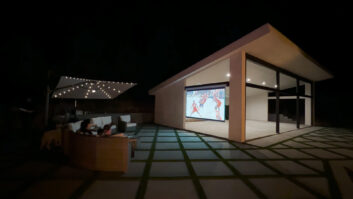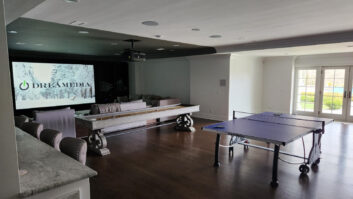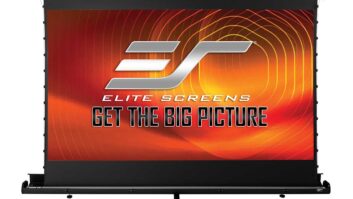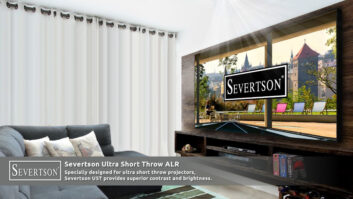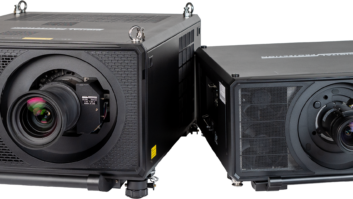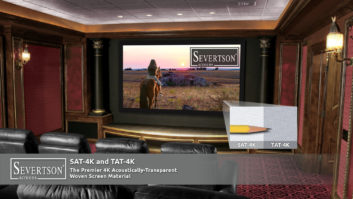
An installation featuring a Seymour-Screen Excellence screen in France. Plato had it all wrong with his Allegory of the Cave. When Socrates told Glaucon his tale of a group of observers, confined to a grotto, unable to observe reality as anything other than a series of moving shadows projected on a blank wall, I don’t think he was spinning some lofty parable about the benefits of education. I think he was dreaming up the first home theater system. The first “man cave,” if you’ll pardon the sexist nomenclature. And let’s face it, for 5th Century B.C.E. Athens, a flame, some shadows, and a flat stone wall were pretty state of the art in terms of man-cave technology.
But even though philosophy hasn’t advanced much in the past two-and-a-half millennia, the surfaces on which we project our moving-picture entertainment have thankfully come a long way since Plato’s cave, and continue to evolve to keep pace with advancements in projection technology, acoustics, and the ever-changing definition of exactly what we mean when we say “home theater.”
So, what’s the biggest trend driving projection screen development these days? If your first guess wasn’t “4K,” you’ve been asleep for the last couple of trade shows (and in a way, I envy you that). 4K–or Ultra High Definition, as the sticklers would have you call it–represents a doubling of both horizontal and vertical resolution over the old full HD standard, and a fourfold increase in the chance that any given pixel will misalign with the surface of a perforated or woven screen. And needless to say, screen manufacturers don’t want that.
“As a projection screen manufacturer, we need to be vigilant in making sure that our surfaces continue to work seamlessly with any type of projector or content, said Bob Hadsell, home theater sales manager at Draper. “Enhancing, and not interfering with, the projected image adds value to the video experience.”
With that, it’s no surprise that Draper’s new custom-manufactured screen material, TecVision, which made its debut at this year’s ISE in Amsterdam, was not only engineered to deliver wider viewing cones and lower, more consistent gloss levels to minimize distortion, but is also stamped with a great big “4K Ready!” badge. Just like that, exclamation point and everything.
As director of marketing at Stewart Filmscreen Dave McFarland pointed out, his company also has been producing screens for 70mm film projection, which has resolution well in advance of 4K video, for years now. “All of our screen materials are capable of handling 4K (and greater) images with ease,” he said, but not all screens capable of handling 4K resolution are necessarily optimal for home applications in which you would use a 4K projector. To that end, Stewart has created a 4K+ logo to help dealers and consumers identify screen materials best suited for Ultra HD projection at home.
Severtson Screens’ two latest acoustically transparent, woven offerings also carry the 4K designation right there in their names. The company’s new SAT-4K screen material was designed to meet or exceed all industry standards for optimum video and acoustic performance, whereas the new TAT-4K screen features a titanium-grey material designed to preserve contrasts even in rooms with a bit of ambient light to contend with. Both are available in screen heights ranging from 37 inches in the company’s flat-panel replacement Impression Series frames up to a staggering 15 feet, 10 inches in a Professional frame.

Above: Screen Innovations recently introduced is new Slate line of screens.
Below: Stewart has created a 4K+ logo to help dealers and consumers identify screen materials best suited for Ultra HD projection at home.

“Consumers are getting pickier and more discerning when it comes to projection screens,” said Kjell Larson, Severtson Screens national sales director. “Venue versatility is becoming more important. As such, [we ’re developing] more custom-sized frames to fill available space and new screen materials to accommodate hidden speakers.”
Making Multi-Purpose Rooms Work
Of course not all residential two-piece projection venues are dedicated home theaters. “We must be mindful that due to changes in economic conditions, more projectors and screens will be used in flex or multi-purpose rooms,” Hadsell noted. “Draper is committed to investigating technology that will maintain contrast and visibility when more ambient light is in the room.”
“The holy grail of projection screen development,” added David Rodger, marketing manager for Elite Screens, “is a material that will give LCD flat-panel performance in a well-lit room. Elite has launched a series of ‘ambient light-rejecting’ materials for just that purpose. Our DarkStar premium-grade product is a retro-reflective material that gives a superb image with sharp contrast levels regardless of the room’s ambient lighting levels.”
At a time when massive flat-panels are invading the screen-size territory formerly dominated by projection screens, that is critically important. But Blake Vackar, director of sales for Screen Innovations–the company who took ambient light rejection to new extremes with its Black Diamond screen material–said, “Consumers/end users are consistently seeking the largest screen possible for their homes and two-piece projection systems still outperform flat-panel TVs in both size and price. As prices continue to drop, and with the ground-breaking improvements on both the projector and screen side, it’s now possible to enjoy viewing in a multi-use environment in any room, anywhere in a home.”
Stewart’s McFarland also pointed out that as large as flat-panels have become, unlike projection screens, they do have their practical limits, especially in terms of “scalability and their ability to produce an immersive experience.”
“Though flat-panels keep getting larger, it is reasonable to assume there is an upper limit to how big they can get before practical issues get in the way (i.e. size, weight and the resulting difficulty in installing),” McFarland said. “Not to mention the fact that the price scales geometrically as you reach the upper size limit. With projection, the price scales in a linear fashion such that, as an example, a 135-inch diagonal fixed-frame screen may be only around $500 or so more than a 92-inch diagonal. Conversely, a 90-inch diagonal 4K TV may be $30,000 (or more) in excess of a 60-inch version.”
Economic considerations notwithstanding, Seymour-Screen Excellence managing director Chris Seymour doesn’t see the trend of ever-increasing screen sizes ending anytime soon. “What used to be considered a maximum image viewing width, 36 to 40 degrees, is now for practical purposes considered average,” Seymour said. “People’s wall spaces aren’t necessarily becoming larger; we’re simply moving toward Fahrenheit 451, where we are increasingly spending time with wall-sized portals into other realities.”
Interestingly enough, though, Stewart’s McFarland doesn’t see flat-panel displays and projection systems as being wholly antagonistic in the coming era of Ultra HD (and, come on, you knew this would all come back to 4K eventually). “Flat-panel manufacturers will likely be driving the 4K movement on the content side, which is necessary to create a larger overall market for 4K systems,” he said. “As flat-panels expand the overall market, they will also elevate opportunities for competing technologies such as projection.”
But unsurprisingly, McFarland still envisions projection screens coming out on top in the 4K era: “The net result is that you will be able to achieve a much, much bigger image with projection at a much better price than competing flat-panel technology. And, since 4K enables a much larger image without losing resolution, projection systems are poised to play an increasingly critical role in the future of the industry.”
Dennis Burger regularly reviews products for Residential Systems.
